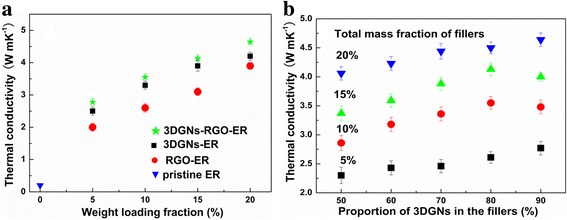Fig. 3.

Thermal conductivities of resulting composites with increased mass factions of fillers. The corresponding thermal performances of various samples are shown in Fig. 3. The thermal conductivity of the pristine ER is 0.2 W/mK, which is far from the requirement for the TIMs. With the increased mass fractions of various fillers, the resulting thermal performances enhance almost in a linearly manner (a). Therein, the RGO nanosheets and 3DGNs co-modified composites display the best performance with identical mass fraction compared with these cases of employing a single filler, and the specific thermal conductivity value is closely related to the proportion of the 3DGNs and RGO nanosheets, demonstrating a synergy between them (b). Although both the RGO nanosheets and 3DGNs are constituted with graphene basal sheets, the distinctions from morphology of these two fillers and chemical state of carbon atoms endow the different functions of them in the TIMs. On the one hand, the high quality and the continuous structure of the 3DGNs make it an excellent fast transport network for phonons, which has been proven in our previous reports. On the other hand, due to the high defect density and the lack of a continuous structure, the phonon transport ability of the RGO filler is weaker than the 3DGNs
